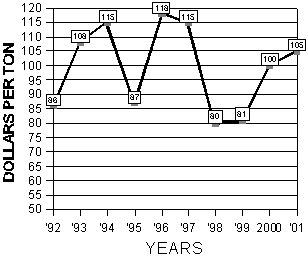Alfalfa Report
Yuma County, Arizona
November 19, 2001
Yuma County Office
2200 W. 28th Street, Ste. 102
Yuma, AZ 85364
(928) 726-3904
(928) 726-8472 FAX
Production Update:
PDF version, 40KB
Fall Dormancy: Shortening daylength and declining temperatures in the fall cause differences in growth among alfalfa cultivars not seen at other times of the year. Fall dormant cultivars have short, prostrate growth compared to tall, erect growth of nondormant cultivars during the fall. Plant breeders have been developing cultivars for mild winter areas that are nondormant in the fall and have increased winter growth ever since the introduction of Hairy Peruvian alfalfa in 1899. Winter survival in the lower elevations in Arizona is influenced more by cutting management and pests than by low temperature.
Insect Management: Cowpea aphid is a black aphid that has become a serious pest of alfalfa. Cowpea aphid may be present throughout the year, but the heaviest infestations usually occur from November through January in western Arizona and southern California. When alfalfa become heavily infested with cowpea aphid, treatment with an insecticide may be warranted to prevent yield loss due to stunting and leaf drop, and to prevent honeydew and sooty mold contamination. Treatment thresholds have not been established for cowpea aphid on alfalfa. Seedling alfalfa may be more susceptible to damage from cowpea aphid.
**WORKSHOP Notice** Arizona Department of Agriculture will conduct Worker Protection Standard workshops to certify Pesticide Safety Trainers (Train the Trainer workshop). 4 hours of CEU credit offered. November 26, in Spanish and November 27 in English. Both are held at the Yuma County Health Department; 2200 W. 28th Street; from 7:30 am - 4:30 pm. Preregister by calling Yuma 928-341-1775 or Phoenix 602-542-0904.
Weed Control: Buctril and Gramoxone are contact herbicides that
will kill small weeds and burn back larger ones. They require good coverage
and will also burn back any alfalfa foliage that they contact. The crop
must be well established to tolerate the herbicide and recover. They work
well where the weeds are so thick that the cover and protect the alfalfa.
| Market Summary |
High
|
Low
|
Average
|
Off grade
|
| Past 2 Weeks ( Nov 6, 2001 to Nov. 18, 2001) |
110
|
100
|
105
|
80-98
|
| Last Year ( Nov 6, 2001 to Nov. 18, 2000) |
105
|
90
|
100
|
70-90
|
10 Year Summary (Nov 6, 2001 to Nov.
18, 1992-2001):

Issued in furtherance of Cooperative Extension work, acts of May 8 and June 30, 1914, in cooperation with the U.S. Department of Agriculture, James A. Christenson, Director Cooperative Extension, College of Agriculture and Life Sciences, The University of Arizona.
The University of Arizona is an equal opportunity, affirmative action institution. The University does not discriminate on the basis of race, color, religion, sex, national origin, age, disability, veteran status, or sexual orientation in its programs and activities.
Any products, services, or organizations that are
mentioned, shown, or indirectly implied in this web document do not imply
endorsement by The University of Arizona.
Information provided by:
Barry Tickes, btickes@ag.arizona.edu Extension Agent, Yuma County
Michael Ottman, mottman@ag.arizona.edu Agronomy Specialist
College of Agriculture, The University of Arizona.
Eric Natwick, etnatwick@ucdavis.edu UCCE Imperial County - Farm Advisor
University of California, Davis, CA.
Material written November 19, 2001.
Forages: Crop Mgmt | Soil Mgmt | Irrigation | Alfalfa Reports | Insects | Diseases | Weeds | Pesticides
Home | Other Crops | Forages
For more Arizona Production Ag Information:
Home | Cotton | Veggies| Forages | Grains | Citrus | Crop x Crop | Insects | Diseases| Weeds | Pesticides | News | Weather | Research | Photos | Contacts | General Info. | Site Map
Copyright © 2001 University of Arizona,
College of Agriculture and Life Sciences
Webmaster: Al Fournier (fournier@ag.arizona.edu)